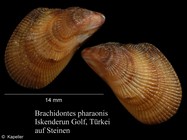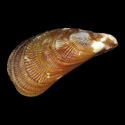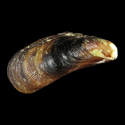WoRMS taxon details
Brachidontes pharaonis (P. Fischer, 1870)
140437 (urn:lsid:marinespecies.org:taxname:140437)
accepted
Species
Brachidontes (Hormomya) karachiensis Melvill & Standen, 1907 · unaccepted > junior subjective synonym
Brachidontes arabicus Jousseaume, 1919 · unaccepted > unavailable name (established in synonymy)
Brachydontes arabicus Jousseaume, 1919 · unaccepted > unavailable name (established in synonymy)
Modiola (Brachydontes) compressula E. von Martens & Thiele, 1908 · unaccepted > junior subjective synonym
Modiola compressula E. von Martens & Thiele, 1908 · unaccepted > junior subjective synonym
Mytilus arabicus (Jousseaume, 1919) · unaccepted > unavailable name (established in synonymy)
Mytilus pharaonis P. Fischer, 1870 · unaccepted (original combination)
marine
(of Mytilus pharaonis P. Fischer, 1870) Fischer, P. (1870). Sur la faune conchyliologique marine des baies de Suez et de l'Akabah. <em>Journal de Conchyliologie.</em> 18: 161-179., available online at http://biodiversitylibrary.org/page/15160580
page(s): 169 [details]
page(s): 169 [details]
Type locality contained in Red Sea
type locality contained in Red Sea [from synonym] [view taxon] [details]
Taxonomy The earlier name Brachidontes ustulatus (Lamarck, 1819) has been put forward by Huber (2010: 550) as the valid name to be...
Taxonomy The earlier name Brachidontes ustulatus (Lamarck, 1819) has been put forward by Huber (2010: 550) as the valid name to be used for this species. However a recent molecular study (Sirna Terranova, Lo Brutto, Arculeo & Mitton, 2007) reveals that the Red Sea and Mediterranean populations, the East African populations and a population from Hong Kong represent three cryptic species of Brachidontes. This implies separating the Red Sea B. pharaonis from the East African B. variabilis and using both names. There is currently an established usage of the name Brachidontes ustulatus for a Western Australian species, and in view of the findings of Sirna Terranova et al., all three names (ustulatus, variabilis and pharaonis) are here listed as "accepted". [details]
MolluscaBase eds. (2025). MolluscaBase. Brachidontes pharaonis (P. Fischer, 1870). Accessed through: World Register of Marine Species at: https://www.marinespecies.org/aphia.php?p=taxdetails&id=140437 on 2025-07-13
Date
action
by
![]() The webpage text is licensed under a Creative Commons
Attribution 4.0 License
The webpage text is licensed under a Creative Commons
Attribution 4.0 License
Nomenclature
original description
(of Mytilus pharaonis P. Fischer, 1870) Fischer, P. (1870). Sur la faune conchyliologique marine des baies de Suez et de l'Akabah. <em>Journal de Conchyliologie.</em> 18: 161-179., available online at http://biodiversitylibrary.org/page/15160580
page(s): 169 [details]
original description (of Modiola (Brachydontes) compressula E. von Martens & Thiele, 1908) Martens, E. von & Thiele, J. (1908). Beschreibung einiger in östlichen Borneo von Dr. Martin Schmidt gesammelten Land- und Süsswasser-Conchylien. <em>Mitteilungen aus dem Zoologischen Museum in Berlin.</em> 4: 251−291, pls 5-6., available online at https://www.biodiversitylibrary.org/page/12200168
page(s): 287 [details]
original description (of Brachydontes arabicus Jousseaume, 1919) Lamy E. (1919). Les moules et les modioles de la Mer Rouge (d'après les matériaux recueillis par le Dr Jousseaume). <em>Bulletin du Muséum National d'Histoire Naturelle.</em> 25: 40-45, 109-114, 173-178., available online at https://www.biodiversitylibrary.org/page/5026693
page(s): 43. [details]
basis of record Gofas, S.; Le Renard, J.; Bouchet, P. (2001). Mollusca. in: Costello, M.J. et al. (eds), European Register of Marine Species: a check-list of the marine species in Europe and a bibliography of guides to their identification. <em>Patrimoines Naturels.</em> 50: 180-213., available online at http://www.vliz.be/imisdocs/publications/ocrd/254404.pdf [details]
page(s): 169 [details]
original description (of Modiola (Brachydontes) compressula E. von Martens & Thiele, 1908) Martens, E. von & Thiele, J. (1908). Beschreibung einiger in östlichen Borneo von Dr. Martin Schmidt gesammelten Land- und Süsswasser-Conchylien. <em>Mitteilungen aus dem Zoologischen Museum in Berlin.</em> 4: 251−291, pls 5-6., available online at https://www.biodiversitylibrary.org/page/12200168
page(s): 287 [details]
original description (of Brachydontes arabicus Jousseaume, 1919) Lamy E. (1919). Les moules et les modioles de la Mer Rouge (d'après les matériaux recueillis par le Dr Jousseaume). <em>Bulletin du Muséum National d'Histoire Naturelle.</em> 25: 40-45, 109-114, 173-178., available online at https://www.biodiversitylibrary.org/page/5026693
page(s): 43. [details]
basis of record Gofas, S.; Le Renard, J.; Bouchet, P. (2001). Mollusca. in: Costello, M.J. et al. (eds), European Register of Marine Species: a check-list of the marine species in Europe and a bibliography of guides to their identification. <em>Patrimoines Naturels.</em> 50: 180-213., available online at http://www.vliz.be/imisdocs/publications/ocrd/254404.pdf [details]
Other
context source (Introduced species)
Katsanevakis, S.; Bogucarskis, K.; Gatto, F.; Vandekerkhove, J.; Deriu, I.; Cardoso A.S. (2012). Building the European Alien Species Information Network (EASIN): a novel approach for the exploration of distributed alien species data. <em>BioInvasions Records.</em> 1: 235-245., available online at http://easin.jrc.ec.europa.eu [details] Available for editors  [request]
[request]
context source (HKRMS) Fong, C. W. (1998). Some aspects of the ecology of the seagrass Zostera japonica in Hong Kong. <em>MPhil thesis. The University of Hong Kong.</em> [details]
additional source Sirna Terranova M., Lo Brutto S., Arculeo M. & Mitton J.B. 2007. A mitochondrial phylogeography of <i>Brachidontes variabilis</i> (Bivalvia: Mytilidae) reveals three cryptic species. <i>Journal of Zoological Systematics and Evolutionary Research</i>, 45(4): 289–298. [details]
additional source Tan, S. H. M.; Wells, F. E.; Lukehurst, S. S.; Strong, E. E.; Sanpanich, K.; Duangdee, T.; Ambarwati, R.; Tan, K. S. (2024). Unravelling the <i>Brachidontes variabilis</i> species complex (Bivalvia: Mytilidae) of the Indo-Pacific region. <em>Journal of Molluscan Studies.</em> 90(4): Published online 5 November., available online at https://doi.org/10.1093/mollus/eyae037 [details]
context source (HKRMS) Fong, C. W. (1998). Some aspects of the ecology of the seagrass Zostera japonica in Hong Kong. <em>MPhil thesis. The University of Hong Kong.</em> [details]
additional source Sirna Terranova M., Lo Brutto S., Arculeo M. & Mitton J.B. 2007. A mitochondrial phylogeography of <i>Brachidontes variabilis</i> (Bivalvia: Mytilidae) reveals three cryptic species. <i>Journal of Zoological Systematics and Evolutionary Research</i>, 45(4): 289–298. [details]
additional source Tan, S. H. M.; Wells, F. E.; Lukehurst, S. S.; Strong, E. E.; Sanpanich, K.; Duangdee, T.; Ambarwati, R.; Tan, K. S. (2024). Unravelling the <i>Brachidontes variabilis</i> species complex (Bivalvia: Mytilidae) of the Indo-Pacific region. <em>Journal of Molluscan Studies.</em> 90(4): Published online 5 November., available online at https://doi.org/10.1093/mollus/eyae037 [details]
 Present
Present  Present in aphia/obis/gbif/idigbio
Present in aphia/obis/gbif/idigbio  Inaccurate
Inaccurate  Introduced: alien
Introduced: alien  Containing type locality
Containing type locality
From editor or global species database
Taxonomy The earlier name Brachidontes ustulatus (Lamarck, 1819) has been put forward by Huber (2010: 550) as the valid name to be used for this species. However a recent molecular study (Sirna Terranova, Lo Brutto, Arculeo & Mitton, 2007) reveals that the Red Sea and Mediterranean populations, the East African populations and a population from Hong Kong represent three cryptic species of Brachidontes. This implies separating the Red Sea B. pharaonis from the East African B. variabilis and using both names. There is currently an established usage of the name Brachidontes ustulatus for a Western Australian species, and in view of the findings of Sirna Terranova et al., all three names (ustulatus, variabilis and pharaonis) are here listed as "accepted". [details]From regional or thematic species database
Introduced species abundance in Maltese part of the Mediterranean Sea - Eastern Basin (Marine Region) : Dominant [details]Introduced species impact in Maltese part of the Mediterranean Sea - Eastern Basin : Outcompetes native species for resources and/or space [details]
Introduced species impact in Maltese part of the Mediterranean Sea - Eastern Basin (Marine Region) : Outcompetes native species for resources and/or space [details]
Introduced species population trend in Maltese part of the Mediterranean Sea - Eastern Basin (Marine Region) : Increasing [details]
Introduced species remark In Maltese part of the Mediterranean Sea - Eastern Basin (Marine Region) : Status questionable in Malta's marine waters [details]
Introduced species vector dispersal in Maltese part of the Mediterranean Sea - Eastern Basin (Marine Region) : Canals: natural range expansion through man-made canals
Suez Canal [details]
Introduced species vector dispersal in Egypt (Nation) : Canals: natural range expansion through man-made canals [details]
Introduced species vector dispersal in Egypt (Nation) : Shipping [details]
Introduced species vector dispersal in Mediterranean Sea - Eastern Basin (IHO Sea Area) : Natural dispersal
Spread as far as Sicily probably via ship fouling. Evidence of pelagic larvae spread on natural currents. [details]
Introduced species vector dispersal in Mediterranean Sea - Eastern Basin (IHO Sea Area) : Ships: accidental as attached or free-living fouling organisms
Spread as far as Sicily probably via ship fouling. Evidence of pelagic larvae spread on natural currents. [details]
Introduced species vector dispersal in Mediterranean Sea - Western Basin (IHO Sea Area) : Natural dispersal
Spread as far as Sicily probably via ship fouling. Evidence of pelagic larvae spread on natural currents. [details]
Introduced species vector dispersal in Mediterranean Sea - Western Basin (IHO Sea Area) : Ships: accidental as attached or free-living fouling organisms
Spread as far as Sicily probably via ship fouling. Evidence of pelagic larvae spread on natural currents. [details]
Introduced species vector dispersal in Maltese part of the Mediterranean Sea - Eastern Basin (Marine Region) : Unknown [details]
Introduced species vector dispersal Croatian part of the Adriatic Sea (Marine Region) Ships: general [details]
Introduced species vector dispersal Greek part of the Aegean Sea (Marine Region) Ships: accidental with ballast water, sea water systems, live wells or other deck basins [details]
Introduced species vector dispersal Greek part of the Aegean Sea (Marine Region) Canals [details]
To Barcode of Life (175 barcodes)
To Biodiversity Heritage Library (3 publications)
To Conchology (Brachidontes pharaonis)
To Conchology (Brachidontes pharaonis)
To European Nucleotide Archive, ENA (Brachidontes pharaonis)
To GenBank (305 nucleotides; 305 proteins)
To GenBank (305 nucleotides; 305 proteins) (from synonym Mytilus pharaonis P. Fischer, 1870)
To Malacopics (Brachidontes pharaonis (P. Fischer, 187) Cyprus, Famagusta, Ayia Napa, beached, coll...
To Malacopics (Brachidontes pharaonis (P. Fischer, 187) Egypt, Al Bahr al Ahmar, Ras Gemsa, at low ...
To Malacopics (Brachidontes pharaonis (P. Fischer, 187) Seychelles, Anse Boileau, low tide, attache...
To MNHN Type collection (IM 2000-33997) (from synonym Mytilus pharaonis P. Fischer, 1870)
To PESI (from synonym Brachidontes arabicus Jousseaume, 1919)
To PESI (from synonym Mytilus pharaonis P. Fischer, 1870)
To PESI
To Biodiversity Heritage Library (3 publications)
To Conchology (Brachidontes pharaonis)
To Conchology (Brachidontes pharaonis)
To European Nucleotide Archive, ENA (Brachidontes pharaonis)
To GenBank (305 nucleotides; 305 proteins)
To GenBank (305 nucleotides; 305 proteins) (from synonym Mytilus pharaonis P. Fischer, 1870)
To Malacopics (Brachidontes pharaonis (P. Fischer, 187) Cyprus, Famagusta, Ayia Napa, beached, coll...
To Malacopics (Brachidontes pharaonis (P. Fischer, 187) Egypt, Al Bahr al Ahmar, Ras Gemsa, at low ...
To Malacopics (Brachidontes pharaonis (P. Fischer, 187) Seychelles, Anse Boileau, low tide, attache...
To MNHN Type collection (IM 2000-33997) (from synonym Mytilus pharaonis P. Fischer, 1870)
To PESI (from synonym Brachidontes arabicus Jousseaume, 1919)
To PESI (from synonym Mytilus pharaonis P. Fischer, 1870)
To PESI








.jpg)
.jpg)